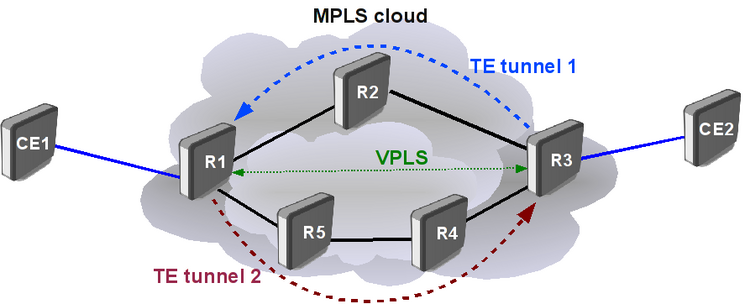Consider following setup:
ether1 connects to R2, ether2 connects to R5
ether1 connects to R1, ether2 connects to R3
ether1 connects to R2, ether2 connects to R4
ether1 connects to R3, ether2 connects to R5
ether1 connects to R4, ether2 connects to R1 After OSPF and LDP setup ensure that ospf is working properly Also make sure MPLS forwarding-table has label bindings ether4 goes to CE routers R1 R3 Make sure that VPLS tunnel is established and running Traffic engineering needs RSVP protocol enabled on head end, tail end and forwarding routers. And additional setup to use CSPF. In our example all routers have the same configuration:Introduction
Application example
IP Connectivity and LDP
R1/system identity set name=R1
/interface bridge add name=lo0
/ip address
add address=192.168.55.1/30 interface=ether1
add address=192.168.55.18/30 interface=ether2
add address=10.255.1.1/32 interface=lo0
/routing ospf instance
set default router-id=10.255.1.1
/routing ospf network
add network=192.168.55.0/24 area=backbone
add network=10.255.1.0/24 area=backbone
/mpls ldp
set enabled=yes lsr-id=10.255.1.1 transport-address=10.255.1.1
/mpls ldp interface
add interface=ether1
add interface=ether2
R2/system identity set name=R2
/interface bridge add name=lo0
/ip address
add address=192.168.55.2/30 interface=ether1
add address=192.168.55.5/30 interface=ether2
add address=10.255.1.2/32 interface=lo0
/routing ospf instance
set default router-id=10.255.1.2
/routing ospf network
add network=192.168.55.0/24 area=backbone
add network=10.255.1.0/24 area=backbone
/mpls ldp
set enabled=yes lsr-id=10.255.1.2 transport-address=10.255.1.2
/mpls ldp interface
add interface=ether1
add interface=ether2
R3/system identity set name=R3
/interface bridge add name=lo0
/ip address
add address=192.168.55.6/30 interface=ether1
add address=192.168.55.9/30 interface=ether2
add address=10.255.1.3/32 interface=lo0
/routing ospf instance
set default router-id=10.255.1.3
/routing ospf network
add network=192.168.55.0/24 area=backbone
add network=10.255.1.0/24 area=backbone
/mpls ldp
set enabled=yes lsr-id=10.255.1.3 transport-address=10.255.1.3
/mpls ldp interface
add interface=ether1
add interface=ether2
R4/system identity set name=R4
/interface bridge add name=lo0
/ip address
add address=192.168.55.10/30 interface=ether1
add address=192.168.55.13/30 interface=ether2
add address=10.255.1.4/32 interface=lo0
/routing ospf instance
set default router-id=10.255.1.4
/routing ospf network
add network=192.168.55.0/24 area=backbone
add network=10.255.1.0/24 area=backbone
/mpls ldp
set enabled=yes lsr-id=10.255.1.4 transport-address=10.255.1.4
/mpls ldp interface
add interface=ether1
add interface=ether2
R5/system identity set name=R5
/interface bridge add name=lo0
/ip address
add address=192.168.55.14/30 interface=ether1
add address=192.168.55.17/30 interface=ether2
add address=10.255.1.5/32 interface=lo0
/routing ospf instance
set default router-id=10.255.1.5
/routing ospf network
add network=192.168.55.0/24 area=backbone
add network=10.255.1.0/24 area=backbone
/mpls ldp
set enabled=yes lsr-id=10.255.1.5 transport-address=10.255.1.5
/mpls ldp interface
add interface=ether1
add interface=ether2
[admin@R1] /routing ospf neighbor> print
0 instance=default router-id=10.255.1.5 address=192.168.55.17 interface=ether2
priority=1 dr-address=192.168.55.17 backup-dr-address=192.168.55.18
state="Full" state-changes=5 ls-retransmits=0 ls-requests=0 db-summaries=0
adjacency=32m17s
1 instance=default router-id=10.255.1.2 address=192.168.55.2 interface=ether1
priority=1 dr-address=192.168.55.2 backup-dr-address=192.168.55.1
state="Full" state-changes=5 ls-retransmits=0 ls-requests=0 db-summaries=0
adjacency=32m17s
[admin@R1] /routing ospf neighbor>
[admin@R1] /ip route> print
Flags: X - disabled, A - active, D - dynamic,
C - connect, S - static, r - rip, b - bgp, o - ospf, m - mme,
B - blackhole, U - unreachable, P - prohibit
# DST-ADDRESS PREF-SRC GATEWAY DISTANCE
0 ADS 0.0.0.0/0 10.1.101.1 0
1 ADC 10.1.101.0/24 10.1.101.9 ether3 0
2 ADC 10.255.1.1/32 10.255.1.1 lo0 0
3 ADo 10.255.1.2/32 192.168.55.2 110
4 ADo 10.255.1.3/32 192.168.55.2 110
5 ADo 10.255.1.4/32 192.168.55.17 110
6 ADo 10.255.1.5/32 192.168.55.17 110
7 ADC 192.168.55.0/30 192.168.55.1 ether1 0
8 ADo 192.168.55.4/30 192.168.55.2 110
9 ADo 192.168.55.8/30 192.168.55.2 110
192.168.55.17
10 ADo 192.168.55.12/30 192.168.55.17 110
11 ADC 192.168.55.16/30 192.168.55.18 ether2 0
[admin@R1] /ip route>
[admin@R1] /mpls forwarding-table> print
Flags: L - ldp, V - vpls, T - traffic-eng
# IN-LABEL OUT-LABELS DESTINATION I NEXTHOP
0 expl-null
1 L 16 10.255.1.5/32 e 192.168.55.17
2 L 17 19 192.168.55.8/30 e 192.168.55.2
3 L 18 19 10.255.1.4/32 e 192.168.55.17
4 L 19 21 10.255.1.3/32 e 192.168.55.2
5 L 20 192.168.55.12/30 e 192.168.55.17
6 L 21 192.168.55.4/30 e 192.168.55.2
7 L 22 10.255.1.2/32 e 192.168.55.2
VPLS tunnel
/interface bridge add name=vpn
/interface vpls
add remote-peer=10.255.1.3 vpls-id=3:3
/interface bridge port
add interface=ether4 bridge=vpn
add interface=vpls1 bridge=vpn
/interface bridge add name=vpn
/interface vpls
add remote-peer=10.255.1.1 vpls-id=3:3
/interface bridge port
add interface=ether4 bridge=vpn
add interface=vpls1 bridge=vpn
[admin@R1] /interface vpls> monitor 0 once
remote-label: 23
local-label: 23
remote-status:
transport: 10.255.1.3/32
transport-nexthop: 192.168.55.2
imposed-labels: 21,23
[admin@R1] /interface vpls>
TE Support
# set up CSPF
/routing ospf instance
set default mpls-te-area=backbone mpls-te-router-id=lo0
# add interfaces on which to run RSVP
/mpls traffic-eng interface
add interface=ether1 bandwidth=10Mbps
add interface=ether2 bandwidth=10Mbps
Manual:TE Tunnels Example
www.basic-mikrotik.blogspot.com on 10.59. VPN -


Join The Community